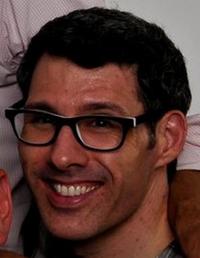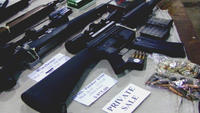-
Biden argues new gun laws needed
Vice President Joe Biden told regional law enforcement officials in Philadelphia on Monday that new gun laws are needed if gun violence is to stop. Biden pledged to take his message around the country.
-
-
Cat Killer Sean Lynde MacKenzie moves to Cyber-Extortion, Cyber-Harassment

Sean Lynde, who pled guilty in New York to criminal animal cruelty and cyber extortion, has now assumed the name “MacKenzie” and is expanding his cyber extortion activities. According to charges filed before the New York Supreme Court, Lynde is now purchasing Web site accounts using other people’s names, posting death threats and defamatory statements on these sites, and then trying to extort funds from the targets. Holding multiple drivers licenses, in multiple names, Lynde reflects how criminals increasingly use the Web to cyber extort businesses and individuals
-
-
Cat Killer Sean Lynde MacKenzie moves to Cyber-Extortion, Cyber-Harassment

Sean Lynde, who pled guilty in New York to criminal animal cruelty and cyber extortion, has now assumed the name “MacKenzie” and is expanding his cyber extortion activities. According to charges filed before the New York Supreme Court, Lynde is now purchasing Web site accounts using other people’s names, posting death threats and defamatory statements on these sites, and then trying to extort funds from the targets. Holding multiple drivers licenses, in multiple names, Lynde reflects how criminals increasingly use the Web to cyber extort businesses and individuals
-
-
Bangladeshi man pleads guilty to trying to blow up the Federal Reserve Bank building

A Bangladeshi man who triedattempted to use a weapon of mass destruction to blow up the New York Federal Reserve Bank has pleaded guilty to the charges. Under the plea agreement, he will faces up to life in prison.
-
-
December, January the top two months in terms of gun purchases in U.S.
New figures released by the FBI show that Americans, during December and January, have been buying guns in record numbers. Analysts say that behind the surge in gun purchases are two events: the Newtown, Connecticut mass shooting and the moves by the Obama administration to introduce – and, in the case of assault weapons, reintroduce – gun control measures. The FBI figures show that in January, the agency performed 2,495,440 gun background checks, initiated by gun sellers before they sold a gun to a customer.
-
-
Number of Muslim-Americans involved in domestic terrorism “vanishingly small”
The number of Muslim-Americans planning or perpetrating terror plots has always been exceedingly small – and it is declining. Fourteen Muslim-Americans were indicted for violent terrorist plots in 2012, down from twenty-one the year before. For the second year in a row, there were no fatalities or injuries from Muslim-American terrorism. For comparison: the United States suffered approximately 14,000 murders in 2012. Since 9/11, Muslim-American terrorism has claimed thirty-three lives in the United States. During the same period, there were more than 180,000 murders committed in the United States.
-
-
Some Democrats face a tough choice on gun control measures

As the gun control debate continues, and different proposed bills are being considered on the Hill, Democrats in red states are facing a tough decision, as their support for gun control measures may become a drag on their re-election prospects in the 2014 congressional elections.
-
-
Illinois expected to change law to allow carrying concealed guns
Illinois is the last state in the union that has a complete ban on carrying concealed weapons. Judge Richard Posner of the 7th Circuit Court of Appeals ruled that the current ban on concealed carry is unconstitutional and said some authorization of citizen concealed carry is long overdue.
-
-
Contours of Hill gun debate emerge
Two issues have emerged as central to the debate over post-Sandy Hook gun control legislation: the first is banning the sale of assault weapons and limiting the size of magazines, the second is requiring a universal background check to make sure those who buy guns are responsible and stable enough to handle them. Hill observers say that a bill requiring universal background check, if carefully drafted to address the concerns of those who live in rural areas, may pass, as would legislation to limit the size of magazines. Banning the sale of assault weapons may be more difficult.
-
-
Majority of Americans -- gun owners and non-gun-owners -- support stronger gun laws

Gun violence claims 31,000 U.S. lives each year in the United States, and the rate of firearms homicides in America is twenty times higher than it is in other economically advanced nations. A new national public opinion survey conducted by researchers at the Johns Hopkins Bloomberg School of Public Health found that the majority of Americans support a broad array of policies to reduce gun violence. For many policies, there was little difference in support between gun owners and non-gun-owners.
-
-
Twitter’s information policy frustrates police, delights customers
Twitter’s robust approach to customers’ privacy has caused consternation among law enforcement agencies, who say that Twitter’s refusal to hand over information on users of the service, except in rare cases, has frustrated criminal investigations. Twitter’s user, though, appreciate the company’s scruples.
-
-
Active-shooter training programs for local law enforcement
Active-shooter training sessions have been in high demand as law enforcement agencies have increased the attention they pay school security after the Sandy Hook Elementary mass shooting. More than twenty-four officers from various northern California law enforcement agencies participated in a two-day active shooter training course funded by DHS.
-
-
Lawmaker unveils bill banning sale, manufacturing of 157 types of semiautomatic guns

Senator Dianne Feinstein (D-California) yesterday unveiled the details of legislation that would ban the sale and manufacture of 157 types of semiautomatic guns and magazines holding more than ten rounds of ammunition. The bill would exempt firearms used for hunting and would grandfather in some guns and magazines. The senator said the bill aims “to dry up the supply of these weapons over time.”
-
-
NRA leader tells gun owners Obama does not understand them
Reacting to President Obama proposals for tighter gun controls, Wayne LaPierre, the executive vice president of the National Rifle Association (NRA), told gun owners on Tuesday that President Obama does not understand them. He said the president wanted to institute a national registry of firearms so he can tax or confiscate their weapons.
-
-
New imaging technique for identifying the age and sex of a corpse
Researchers have developed a new technique for identifying the age and sex of a corpse. It is based on a computing system which relies on free software, and has a reliability of 95 percent.
-
More headlines
The long view
How Male Grievance Fuels Radicalization and Extremist Violence
Social extremism is evolving in reach and form. While traditional racial supremacy ideologies remain, contemporary movements are now often fueled by something more personal and emotionally resonant: male grievance.
